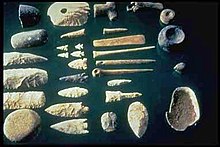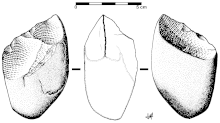Stone tool: Difference between revisions
→See also: + manuport: stone/ rock fragment, deported on purpose and used as a tool but no toolmaking |
→Mode I: The Oldowan Industry (2.6mya-250,000ya): changed "although" to "and" for clarity -- Alan Hartley |
||
| Line 11: | Line 11: | ||
[[Image:Chopping tool.gif|thumb|right|A typical Oldowan simple chopping-tool.]] |
[[Image:Chopping tool.gif|thumb|right|A typical Oldowan simple chopping-tool.]] |
||
The earliest stone tools in human history are [[Mode 1]] tools, and come from what has been termed the [[Oldowan Industry]], named after the archaeological site of [[Olduvai Gorge]] in [[Tanzania]] where a number of examples have been found. The Oldowan tools were characterised by their simple construction, predominantly comprising of [[lithic core|core]] forms. These cores had initially been rocks that had been hit hard by a spherical [[hammerstone]] to cause a [[conchoidal fracture]] that knocked flakes off of the top, creating a sharp tip. The earliest known Oldowan tools yet found date from 2.6 million years ago, during the [[Lower Palaeolithic]] period, and have been uncovered at [[Gona]] in [[Ethiopia]].<ref>Semaw, S., M. J. Rogers, J. Quade, P. R. Renne, R. F. Butler, M. Domínguez-Rodrigo, D. Stout, W. S. Hart, T. Pickering, and S. W. Simpson. 2003. 2.6-Million-year-old stone tools and associated bones from OGS-6 and OGS-7, Gona, Afar, Ethiopia. ''Journal of Human Evolution'' 45:169-177. |
The earliest stone tools in human history are [[Mode 1]] tools, and come from what has been termed the [[Oldowan Industry]], named after the archaeological site of [[Olduvai Gorge]] in [[Tanzania]] where a number of examples have been found. The Oldowan tools were characterised by their simple construction, predominantly comprising of [[lithic core|core]] forms. These cores had initially been rocks that had been hit hard by a spherical [[hammerstone]] to cause a [[conchoidal fracture]] that knocked flakes off of the top, creating a sharp tip. The earliest known Oldowan tools yet found date from 2.6 million years ago, during the [[Lower Palaeolithic]] period, and have been uncovered at [[Gona]] in [[Ethiopia]].<ref>Semaw, S., M. J. Rogers, J. Quade, P. R. Renne, R. F. Butler, M. Domínguez-Rodrigo, D. Stout, W. S. Hart, T. Pickering, and S. W. Simpson. 2003. 2.6-Million-year-old stone tools and associated bones from OGS-6 and OGS-7, Gona, Afar, Ethiopia. ''Journal of Human Evolution'' 45:169-177. |
||
</ref> After this date, the Oldowan Industry subsequently spread throughout much of [[Africa]], although archaeologists are currently unsure which [[Hominin]] species first developed them, with some speculating that it was ''[[Australopithecus garhi]]'', |
</ref> After this date, the Oldowan Industry subsequently spread throughout much of [[Africa]], although archaeologists are currently unsure which [[Hominin]] species first developed them, with some speculating that it was ''[[Australopithecus garhi]]'', and others believing that it was in fact the more highly evolved ''[[Homo habilis]]''. <ref>Toth, Nicholas and Schick, Kathy (2009). ‘African Origins’ in ''The Human Past: World Prehistory and the Development of Human Societies''. Second Edition. (Ed:Chris Scarre). London: Thames and Hudson. p.67-68.</ref> The Industry flourished in southern and eastern Africa between 2.4 and 1.7 million years ago, but was also spread out of Africa and into [[Eurasia]] by travelling hominins, who took it as far east as [[Java]] by 1.8 million years ago and [[Northern China]] by 1.6 million years ago. |
||
===Mode II: The Acheulean Industry (1.65mya-250,000ya)=== |
===Mode II: The Acheulean Industry (1.65mya-250,000ya)=== |
||
Revision as of 03:31, 29 August 2010

A stone tool is, in the most general sense, any tool made either partially or entirely out of stone. Although stone tool-dependent societies and cultures still exist today, most stone tools are associated with prehistoric, particularly Stone Age cultures that have become extinct. Archaeologists often study such prehistoric societies, and refer to the study of stone tools as lithic analysis. Stone has been used to make a wide variety of different tools throughout history, including arrow heads, spearpoints and querns. Stone tools may be made of either ground stone or chipped stone, and a person who creates tools out of the latter is known as a flintknapper.
Chipped stone tools are made from cryptocrystalline materials such as chert or flint, radiolarite, chalcedony, basalt, quartzite and obsidian via a process known as lithic reduction. One simple form of reduction is to strike stone flakes from a nucleus (core) of material using a hammerstone or similar hard hammer fabricator. If the goal of the reduction strategy is to produce flakes, the remnant lithic core may be discarded once it has become too small to use. In some strategies, however, a flintknapper reduces the core to a rough unifacial or bifacial preform, which is further reduced using soft hammer flaking techniques or by pressure flaking the edges. More complex forms of reduction include the production of highly standardized blades, which can then be fashioned into a variety of tools such as scrapers, knives, sickles and microliths. In general terms, chipped stone tools are nearly ubiquitous in all pre-metal-using societies because they are easily manufactured, the tool stone is usually plentiful, and they are easy to transport and sharpen.
History
The stone tools used in the period of the Palaeolithic are divided into four "modes", each of which designate a different form of complexity, and which in most cases followed a rough chronological order.[1]
Mode I: The Oldowan Industry (2.6mya-250,000ya)

The earliest stone tools in human history are Mode 1 tools, and come from what has been termed the Oldowan Industry, named after the archaeological site of Olduvai Gorge in Tanzania where a number of examples have been found. The Oldowan tools were characterised by their simple construction, predominantly comprising of core forms. These cores had initially been rocks that had been hit hard by a spherical hammerstone to cause a conchoidal fracture that knocked flakes off of the top, creating a sharp tip. The earliest known Oldowan tools yet found date from 2.6 million years ago, during the Lower Palaeolithic period, and have been uncovered at Gona in Ethiopia.[2] After this date, the Oldowan Industry subsequently spread throughout much of Africa, although archaeologists are currently unsure which Hominin species first developed them, with some speculating that it was Australopithecus garhi, and others believing that it was in fact the more highly evolved Homo habilis. [3] The Industry flourished in southern and eastern Africa between 2.4 and 1.7 million years ago, but was also spread out of Africa and into Eurasia by travelling hominins, who took it as far east as Java by 1.8 million years ago and Northern China by 1.6 million years ago.
Mode II: The Acheulean Industry (1.65mya-250,000ya)

Eventually, more complex, Mode 2 tools began to be developed through the Acheulean Industry, named after the site of Saint Acheul in France. The Acheulean was characterised not by the core, but by the biface, the most notable form of which was the hand axe. The Acheulean first appears in the archaeological record 1.65 million years ago in the West Turkana area of Tanzania and subsequently spread through much of southern and eastern Africa, often existing alongside the Oldowan Industry. The main hominin species who used Acheulean technology were the African-based Homo ergaster and the Eurasian based Homo erectus.
Mode III: The Mousterian Industry
Eventually, the Acheulean in Europe was replaced by a Mode 3 lithic technology known as the Mousterian Industry, which was named after the site of Le Moustier in France, where examples were first uncovered in the 1860s. Evolving from the Acheulean, it adopted the Levallois technique to produce smaller and sharper knife-like tools as well as scrapers. The Mousterian Industry was developed and used primarily by the Neanderthals, a native European and Middle Eastern hominin species.[4]
Mode IV: The Aurignacian Industry
The long blades (rather than flakes) of the Upper Palaeolithic Mode 4 industries appeared during the Upper Palaeolithic[5]. The Aurignacian culture is a good example of mode 4 tool production.
Mode V: The Microlithic Industries
Mode 5 stone tools involve the production of Microliths. Examples include the Magdalenian culture.
Neolithic industries


Ground stone tools became important during the Neolithic period. These ground or polished implements are manufactured from larger-grained materials such as basalt, greenstone and some forms of rhyolite which are not suitable for flaking. The greenstone industry was important in the English Lake District, and is known as the Langdale axe industry. Ground stone implements included adzes, celts, and axes, which were manufactured using a labour-intensive, time-consuming method of repeated grinding against an abrasive stone, often using water as a lubricant. Because of their coarse surfaces, some ground stone tools were used for grinding plant foods and were polished not just by intentional shaping, but also by use. Manos are hand stones used in conjunction with metates for grinding corn or grain. Polishing increased the intrinsic mechanical strength of the axe. Polished stone axes were important for the widespread clearance of woods and forest during the Neolithic period, when crop and livestock farming developed on a large scale.
Tool stone
Generally speaking, tools that require a sharp edge are made using cryptocrystalline materials that fracture in an easily-controlled conchoidal manner. Cryptocrystalline tool stones include flint and chert, which are fine-grained sedimentary materials; rhyolite, basalt, and felsite, which are volcanic rocks; and obsidian, a form of natural glass created by igneous processes. These materials fracture in a predictable fashion, and are easily resharpened. For more information on this subject, see lithic reduction.
Coarse-grained materials, such as granite and sandstone, may also be used as tool stones, but for a very different purpose: they are ideal for ground stone artifacts. Whereas cryptocrystalline materials are most useful for killing and processing animals, large-grained materials are usually used for processing plant matter. Their rough faces often make excellent surfaces for grinding plant seeds. With much effort, some large-grained stones may be ground down into awls, adzes, and axes.[6]
See also
- lithic technology
- knapping
- Flint
- Flint tool
- Manuport
- Langdale axe industry
- Cissbury
- Grimes Graves
- Great Orme
- Penmaenmawr
- Spiennes
- Tievebulliagh
References
- ^ Barton, RNE, Stone Age Britain English Heritage/BT Batsford:London 1997 qtd in Butler, 2005. See also Wymer, JJ, The Lower Palaeolithic Occupation of Britain, Wessex Archaeology and English Heritage, 1999.
- ^ Semaw, S., M. J. Rogers, J. Quade, P. R. Renne, R. F. Butler, M. Domínguez-Rodrigo, D. Stout, W. S. Hart, T. Pickering, and S. W. Simpson. 2003. 2.6-Million-year-old stone tools and associated bones from OGS-6 and OGS-7, Gona, Afar, Ethiopia. Journal of Human Evolution 45:169-177.
- ^ Toth, Nicholas and Schick, Kathy (2009). ‘African Origins’ in The Human Past: World Prehistory and the Development of Human Societies. Second Edition. (Ed:Chris Scarre). London: Thames and Hudson. p.67-68.
- ^ Pettitt, Paul (2009). “The Rise of Modern Humans” in The Human Past: World Prehistory and the Development of Human Societies. Second Edition (Ed: Chris Scarre). London: Thames and Hudson. Page 149-151.
- ^ Lewin, R., Foley, R. A. 2004. Principles of Human Evolution (2nd Ed.) Blackwell Science, UK. ISBN 0-632-04704-6
- ^ Andrefsky Jr., William (2005). Lithics: Macroscopic Approaches to Analysis (Second Edition ed.). Cambridge University Press. ISBN 0-521-61500-3.
{{cite book}}:|edition=has extra text (help)
